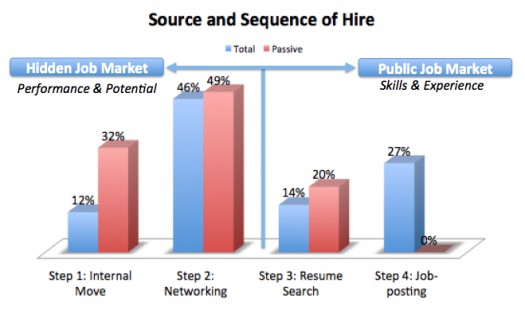 I decided to ask 1,582 U.S. company employees how they go their last job. I gave them four choices:
I decided to ask 1,582 U.S. company employees how they go their last job. I gave them four choices:
- Internal move or promotion
- Some type of proactive networking activity, or referred by someone within the company
- Contacted by a recruiter or hiring manager who found their resume or LinkedIn profile
- Responded to a job posting
I also asked if they were actively looking for a job at the time, or not. The results of this survey are shown in the graphic. Here’s a link to the survey itself if you’d like to take it and/or pass it on, and the preliminary analysis. Even though the data is not perfect, here are some obvious conclusions:
- Most jobs in the U.S. are filled either via an internal move or through some networking activity (Steps 1 and 2). For active candidates these two steps totaled 58%, and for passive candidates an astonishing 81%. If suitable candidates are not found at this point, companies default to the “post-a-job-description” and “look-for-resumes” approach (Steps 3 and 4).
- Only 27% of active candidates found their job by responding to an ad. Another 14% of active candidate got hired after their resume or LinkedIn profile was found by a recruiter or hiring manager. Key finding: if recruiters are spending more than 25% of their time posting ads or searching for resumes, they’re missing the heart of the talent market.
- While networking is essential for job seekers (46% of active candidates and 49% of passive candidates found jobs this way) most corporate recruiters are not fully invested in this approach. It takes a great deal of skill and subject-matter expertise to do this effectively. Since this is how the best people are found, you might want to review a copy of our latest Recruiter Circle of Excellence Competency Model to see where you and/or your recruiting team ranks on this score.
- The sequenced four-step process hiring managers use to fill positions is typically below the radar, yet it’s of strategic importance. The big point: the more direct knowledge the hiring manager has regarding the person being hired the less the person’s skills, academics, and experiences matter. For example, internal promotions are by definition based on past performance and future potential, since the objective of the move is to provide the person with more skills and experience. People who are hired externally, but are highly regarded and referred by a trusted source, are evaluated on a reasonable balance of past performance and skills and experience. Yet an unknown person who responds to a job posting or found in some resume database is screened and evaluated primarily on the depth and quality of his/her skills, academics ,and past experiences.
- This four-step job filling sequence creates a hidden job market where performance and potential are more important than skills, experience, and academics. In the public job market this situation is reversed. This is probably the reason so few passive candidates are hired in the public job market — they are not interested in taking lateral transfer or doing the same work. Instead they’re looking for better careers. Key finding for recruiters: if a company wants to hire more talented passive candidates they need to find these people before the job requisition is officially open! (Note: please don’t use some legal excuse for not doing this. I asked David Goldstein, one of the nation’s top labor attorneys with Littler Mendelson, to validate the use of performance as an objective selection criteria. He did.)
I know the results of the survey are imprecise and the data is subject to swings of plus or minus five percent in any category, but this is no reason for not plowing forward. This is what bureaucrats do: procrastinate and make excuses why they can’t find enough good people. Real recruiters put their heads down and start making phone calls connecting with great people they don’t know. That’s the moral of this survey.